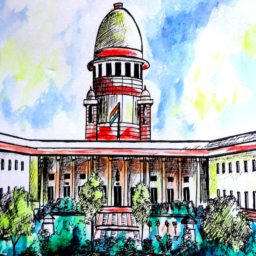INTRODUCTION
Throughout human history, women have played a vital role in making history [1]. Women’s status in society and their employment in society reflect the nation’s overall development. A country’s social, economic, or political progress will deteriorate and stagnate as long as women do not participate actively in national activities. It is ironic and tragic, however, that women generally are not taken seriously by their superiors, colleagues, or society at large. Due to their family responsibilities, women have a difficult time balancing home and career. The fact that Indian women are now working outside of the home does not diminish the fact that they still have a long way to go culturally, socially, and economically.[2]
The perception is that gender bias against working women starts at the recruitment stage. In Indian society, most men do not accept the possibility that women can work alongside men in all fields, except for a few narrow ones such as teaching, nursing, and clerical work. In general, Indian women, even those with highly qualified skills, opt for low-demand jobs because of undervaluation. The responsibility of women lies in effectively managing their multiple roles, both domestically and professionally. The legal profession presents them with numerous challenges regularly, whether they are moulding themselves or practising law.
Challenges faced by female practitioners in courts
Women feel the pressure to the rap of the work before it gets dark because as a woman feels unsafe. In addition, the court’s infrastructure is not conducive to women’s needs, such as the restrictive availability of washrooms and the feeling of unwelcomeness in the common working areas.[3] Many Woman lawyer sometimes chooses cases based on the safety and infrastructure of the court and persistent discrimination is regularly faced in the male-dominated field by women. Even the clients often prefer male representatives because women may not appear in court because of their family commitments or personal issues.
Legal firms and senior lawyers have the preference for hiring men it is an upheld battle to be a woman lawyer and the country’s top judge agrees to this. At the women lawyers’ event, the country’s chief justice acknowledged that the country’s courtrooms are still not inclusive nor are there enough women in the Higher Judiciary. The glass ceiling will only be broken if women of different classes and different religions are promoted at all levels.
Gender Discrimination
It’s almost a law of nature that women lawyers are judged and compared a lot to their male counterparts.[4] In a lower court you can see women active but as you move up the ladder the number of women especially the young women diminishes as go up to the apex court.
There is a change in situation from what was 30-40 years ago, now there is an equal ratio of males and females in Law schools and somewhere females are more than males candidates in Law School, But we can see women lawyers are dropping out of practice due to either non-encouragement or because of the environment being so in-hospital or so vulnerable that they are probably dropping out of these situations. There may be circumstances that force to move away from the situation there are challenges for women not only a person but also challenges to growth Advancement of a career in way which is caused by the fact she is a woman and she is in a male dominant progressing profession of being a lawyer.
Women have a very distinct choice between their personal life and professional life and at one point she is expected to choose and it is not a matter of concern for a man. as an associate, women have to face the choice of getting married or getting a promotion where there is a very tangible choice a woman has to make or is expected to make because social connotations come with being a woman. As a result, a glass ceiling implies that women face an impenetrable barrier that prevents them from moving upward. Below this barrier, women can get promoted, beyond this they are not. Women are subjected to unequal treatment around the world because of this ubiquitous glass ceiling.[5]
There are several ways in which women face gender bias in litigation. Pinky Anand, an experienced lawyer, believes that “women confront gender bias at several levels when engaged in litigation. Daily, women face clients, lawyers, and judges, the majority of whom are men. It is perceived as cantankerous when they raise their voices to voice their opinions rather than as assertive. In some cases, their merits are obscured by this perception, and they are labelled as aggressive.”[6]
Gender-Wage Gap
Despite the availability of women’s talent, most corporations are reluctant to invest in it. The cost of maternity leave and benefits is viewed negatively by many companies. It should come as no surprise then that 84% of women in law firms and companies thought their employers performed below average on childcare assistance programs and that 74% thought they did below average in terms of promoting or mentoring women within the corporation. Litigation does not fare any better. As the court system is structured, women in litigation don’t have 12 weeks of maternity leave.
Women are equally represented at the most prestigious law schools and the very beginnings of their legal careers, but they do not enjoy the same representation at their workplaces or in higher positions after graduation. Systemic discrimination hinders their upward mobility. It is often pointed out by critics that women are given unchallenging work and that there are gender biases present in the fraternity. Women are less likely to receive investment by law firms, for fear that they may leave the profession for other reasons later on. Women lawyers are less likely to be invested in by employers at critical points in their careers because of this mindset.[7]
Work-life balance: CONCLUDING REMARKS
Female lawyers face more challenges in bringing a balance between their career and their family. The study on the Indian legal profession, Challenges Faced by Indian Women Legal Professionals, to an extent validates that like many working women, women lawyers to are forced to choose between careers and children. Researchers interviewed 81 women lawyers over nine months and uncovered some unsurprising findings. 75% of women in law firms, 43% of women in companies, and 52% of those in the litigation said that maternity leaves adversely affected their careers. The worst affected seem to be women in law firms, followed by women in litigation.[8]. The loss of promotion was experienced by 21% of women in law firms despite being deserving of it.[9].
Author(s) Name: Siddhima (Bhartiya Vidyapith University, Pune)















